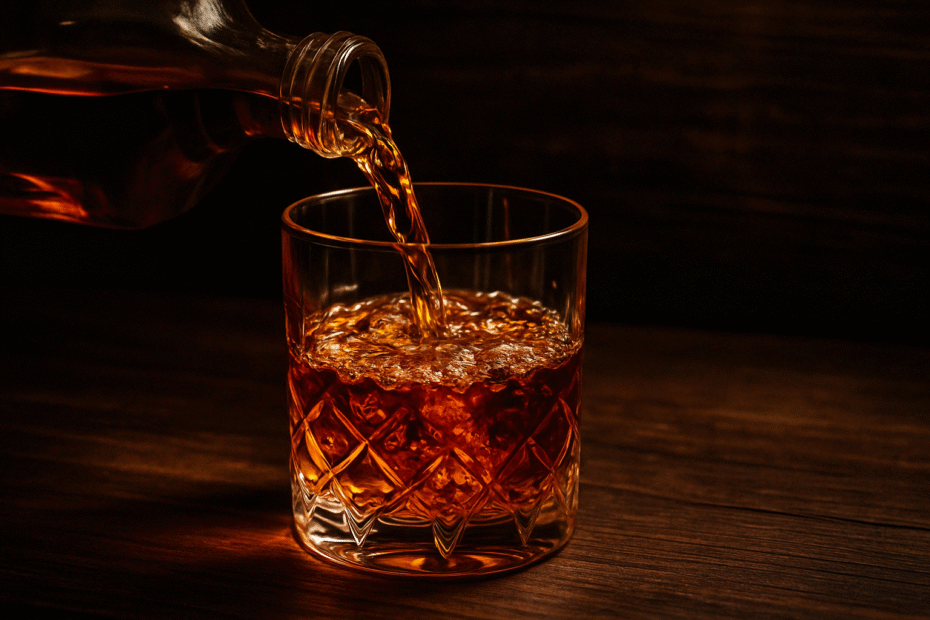Bourbon stands as an iconic American spirit with a rich heritage and distinctive character. This comprehensive Bourbon Guide aims to provide a thorough understanding of bourbon, from its historical roots and legal requirements to production methods and tasting approaches. Whether you’re new to bourbon or looking to expand your knowledge, this guide serves as a valuable resource for appreciating America’s native spirit. If you’re curious about what distinguishes bourbon from other whiskeys, you might want to explore whether whiskey and bourbon are the same or learn more about what bourbon is made from.
History and Origins of Bourbon
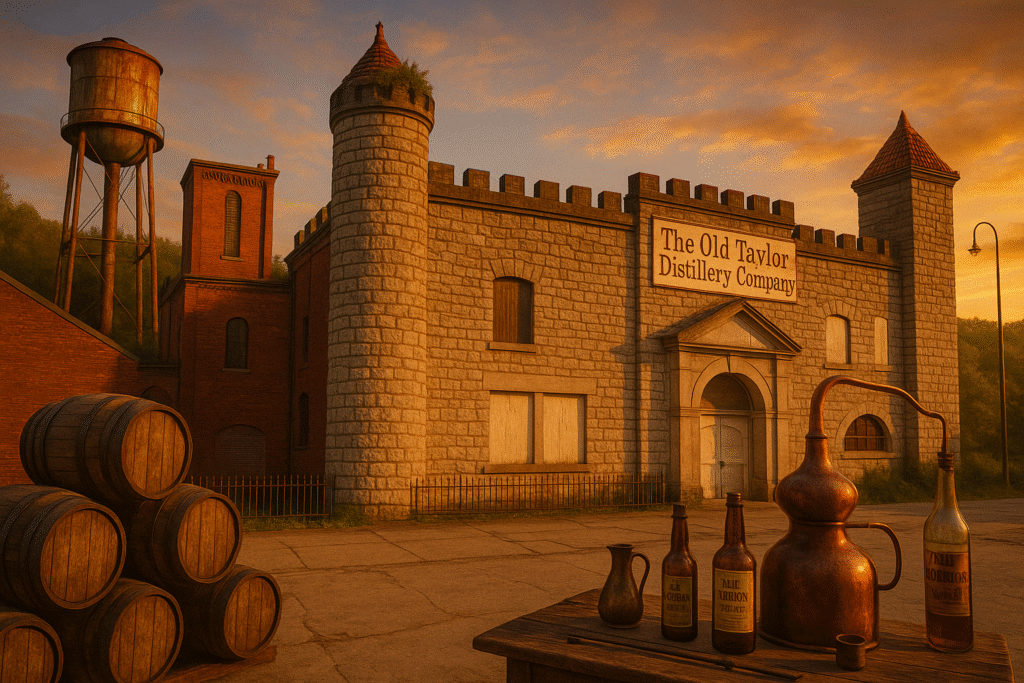
Early Beginnings
The story of bourbon begins in the late 18th century, when settlers brought distilling traditions from Europe to America. As these settlers moved westward, many established themselves in what would later become Kentucky. The abundance of corn in this region, combined with the limestone-filtered water and favourable climate, created ideal conditions for whiskey production.
There is no single “inventor” of bourbon, which gradually evolved into its present form during the late 19th century. While various origin stories exist, the spirit developed organically as distillers refined their techniques over generations.
The Name “Bourbon”
The origin of the name “bourbon” remains somewhat contested. One popular theory suggests the whiskey was named after Bourbon County, Kentucky, which was established in 1785 and originally encompassed a much larger area than it does today.
An alternative theory proposes that the name comes from Bourbon Street in New Orleans, a major port where Kentucky whiskey was sold as a less expensive alternative to French cognac.
Bourbon’s Evolution
Through the 19th century, bourbon production methods were refined and standardised. Key developments included:
- The adoption of the sour mash process
- The use of charred oak barrels for ageing
- Consistent corn-dominant recipes
Many of bourbon’s legal requirements were established in the early 20th century. The Pure Food and Drug Act of 1906 began the process of legally defining American whiskey, though it initially left room for interpretation. President Taft signed off on an official legal definition in 1909, which established important parameters regarding what could be added to whiskey.
Prohibition and Recovery
Prohibition (1919-1933) severely impacted the bourbon industry, forcing many distilleries to close permanently. The repeal of Prohibition in 1933 allowed for the revival of bourbon production, though the industry took decades to fully recover.
Official Recognition
In 1964, bourbon gained official recognition when Senate Concurrent Resolution 19 formally declared bourbon as “a distinctive product of the United States,” cementing its status as America’s native spirit.
Legal Requirements for Bourbon Designation

For a whiskey to legally qualify as bourbon, it must meet several specific requirements established by U.S. federal regulations:
Bourbon is a type of American whiskey with a distinct identity shaped by specific legal requirements. All bourbon must be made in the United States. Contrary to popular belief, bourbon doesn’t have to be made in Kentucky, although the state is certainly famous for producing approximately 95% of the world’s bourbon.
Ingredients and Production
- Mash Bill Requirements: The mash bill (recipe) must contain at least 51% corn. The remaining 49% typically includes other grains like rye or wheat and a small portion of malted barley.
- Distillation Specifications: The spirit must be distilled to no more than 160 proof (80% alcohol by volume).
- Barreling Requirements: It must be aged in new, charred oak containers. In practice, these containers are generally barrels made from American white oak.
- Barreling Proof: When placed in the barrel, the spirit must be no more than 62.5% alcohol by volume (ABV).
- Bottling Proof: The bottled spirit must be a minimum of 40% ABV (80 proof).
- Additives Prohibition: By law, nothing can be added at bottling except water. Nothing is added that might enhance flavour, add sweetness, or alter colour.
Age Designations
While there’s no minimum ageing period for bourbon, to be labelled “straight bourbon,” it must be aged for at least two years. Many premium bourbons are aged for four years or more.
Straight bourbon must be aged for a minimum of two years, but straight bourbon aged between two to four years must display an age statement on the bottle indicating the age of the youngest spirit in the bottle. Straight bourbon aged over four years requires no age statement.
Special Designations
Bottled-in-Bond: Bottled-in-bond relates to an American-made distilled beverage that meets the legal requirements laid out in the Bottled-in-Bond Act of 1897. The act dictated that spirits must be the product of one distilling season from one distillery and bottled at 100 proof. It must also be aged for at least four years in a federally bonded warehouse.
Blended Bourbon: Bourbon that is labelled blended (or as a blend) may contain added colouring, flavouring, and other spirits, such as un-aged neutral grain spirits, but at least 51% of the product must be straight bourbon.
High Rye Bourbon: “High rye bourbon” is not a legally defined term, but usually means a bourbon with 20–35% rye in its mash bill.
Production Process from Grain to Bottle
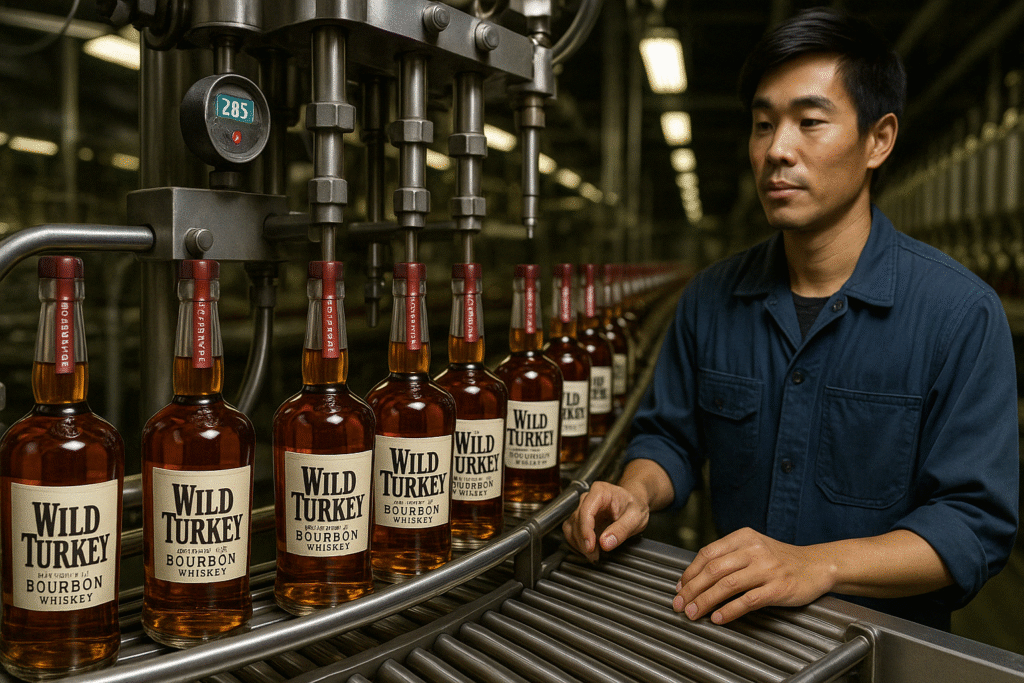
The creation of bourbon involves several key steps that transform raw grains into a complex, flavorful spirit:
1. Mash Bill Formulation
The master distiller first determines the recipe (or mash bill) of different grains to use for the bourbon’s creation. The American Bourbon Association requires that bourbon sold in the United States is distilled from a mixture of grains (or mash) that must be comprised of at least 51 percent corn. The remainder of the smaller grains is malted barley, wheat, or rye.
Common mash bill compositions include:
- Traditional: 70-80% corn, 10-15% rye, 5-10% malted barley
- High-rye: 60-70% corn, 20-35% rye, 5-10% malted barley
- Wheated: 70-80% corn, 10-20% wheat, 5-10% malted barley
2. Milling and Cooking
The selected grains are ground into meal and then cooked in water. Typically, each grain is cooked separately at different temperatures to maximise starch extraction:
- Corn requires the highest cooking temperature
- Rye or wheat is added at a moderate temperature
- Malted barley, which contains natural enzymes, is added last at a lower temperature
3. Fermentation and Yeast Selection
The selection and propagation of yeast is a meticulous process. Each distillery relies on specific yeast strains that are cultivated in their own tanks to produce the characteristic flavor profiles of their whiskeys.
Bourbon production is similar to the processes of other whiskeys in that Bourbon improves as it spends more time in the barrel. Whiskey is forced in and out of the barrel’s wood as temperatures fluctuate. This imparts vanilla-like flavors and makes the whiskey have a more complex taste.
4. Distillation
Distillation is a process that purifies a liquid by heating and vaporising it, then collecting the vapour as it recondenses into a liquid. The resulting liquid (distillate) is considered purer (since it leaves behind many impurities when it evaporates) and more alcoholic. A majority of bourbon is put through the distilling process twice. The first round involves distillation in a beer still. The second round involves distillation in heated copper pot stills, referred to as doublers or thumpers. These rounds serve to boost the alcohol content and remove impurities.
5. Barreling and Maturation
In Kentucky and Missouri, companies specialise in the production of barrels made from American white oak. These barrels may only be used once for straight bourbon whiskey and hold around 53 American gallons (approximately 200 litres).
Toasting is a special method that gives the bourbon its typical flavour. This involves heating the inside of the barrels over a gentle fire, which caramelises the wood sugar and creates a red layer.
After toasting, the barrels are charred to various levels, from a light char (Level 1) to a heavy char (Level 4). This charring:
- Creates a layer of activated carbon that filters the spirit
- Breaks down wood sugars that will be absorbed by the bourbon
- Opens the wood’s structure to allow for greater interaction
The spirit gains its colour and much of its flavour from the caramelised sugars and vanillins in the charred wood.
6. Ageing and Warehouse Conditions
The layer of charred oak inside the barrel also gives whiskey its dark brown colour. This process cannot go on forever. Because of evaporation, there is less whiskey left in an ageing barrel every year. Eventually, the barrel would become empty. If Bourbon spends too much time in a barrel, it can create an unpleasant and woody taste that makes drinking the spirit unfavourable. The key is to figure out when a barrel has matured to perfection without it ageing too long.
Factors affecting ageing include:
- Warehouse location and design (traditional vs. climate-controlled)
- Barrel placement within the warehouse (higher floors experience greater temperature fluctuations)
- Seasonal temperature variations
7. Batching and Bottling
When distillers bottle their standard Bourbon, they go to rickhouses where the whiskey is stored and aged. They pull a bunch of barrels to be dumped together in tanks and mixed until the Bourbon matches the flavour profile that is typically bottled. Every barrel tastes slightly different due to small differences in wood and storage location within the rickhouse. Hundreds of barrels can be blended to get a relatively consistent flavour that matches each batch of Bourbon.
During bottling, the bourbon may be:
- Filtered or non-chill filtered
- Diluted with water to reach the desired proof
- Bottled at barrel proof/cask strength with no dilution
Bourbon Regions and Their Characteristics
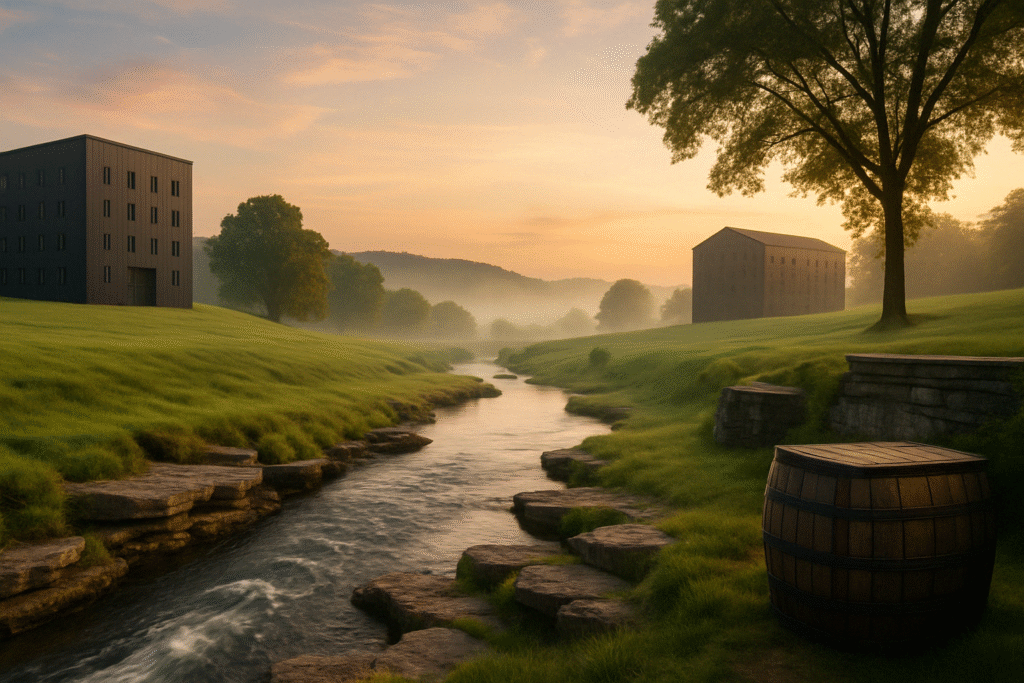
While bourbon can legally be produced anywhere in the United States, certain regions have developed distinctive styles and production traditions:
Kentucky
As the historical center of bourbon production, Kentucky produces approximately 95% of the world’s bourbon. The state’s limestone-filtered water, seasonal temperature fluctuations, and deep distilling heritage contribute to its prominence.
Key bourbon-producing areas within Kentucky include:
- Bourbon County: Despite lending its name to the spirit, this county is now home to relatively few distilleries compared to other regions.
- Louisville and Jefferson County: Home to many historic and contemporary distilleries.
- Bardstown: Often called the “Bourbon Capital of the World,” this small city houses numerous major distilleries.
- Frankfort and Franklin County: Location of several historic distilleries taking advantage of the Kentucky River water.
Tennessee
Tennessee is home to other major bourbon makers, although most prefer to call their product “Tennessee whiskey” instead, including giant Jack Daniel’s. It is legally defined under Tennessee House Bill 1084, the North American Free Trade Agreement and at least one other international trade agreement as the recognized name for a straight bourbon whiskey produced in Tennessee.
Although some Tennessee whiskey makers maintain that a pre-ageing filtration through chunks of maple charcoal, known as the Lincoln County Process and legally mandated since 2013, makes its flavour distinct from bourbon, U.S. regulations defining bourbon neither require nor prohibit its use.
Indiana
The largest bourbon distiller outside of Kentucky and Tennessee is MGP of Indiana, which primarily wholesales its spirits products to bottling companies that sell them under about 50 different brand names.
Emerging Regions
In recent years, craft bourbon production has expanded across the United States, with notable distilleries emerging in:
- New York
- Colorado
- Texas
- Washington
- Oregon
- California
Each region brings its own approach to bourbon production, often influenced by local climate conditions, water sources, and regional grain availability.
Flavour Profiles and Tasting Methodology
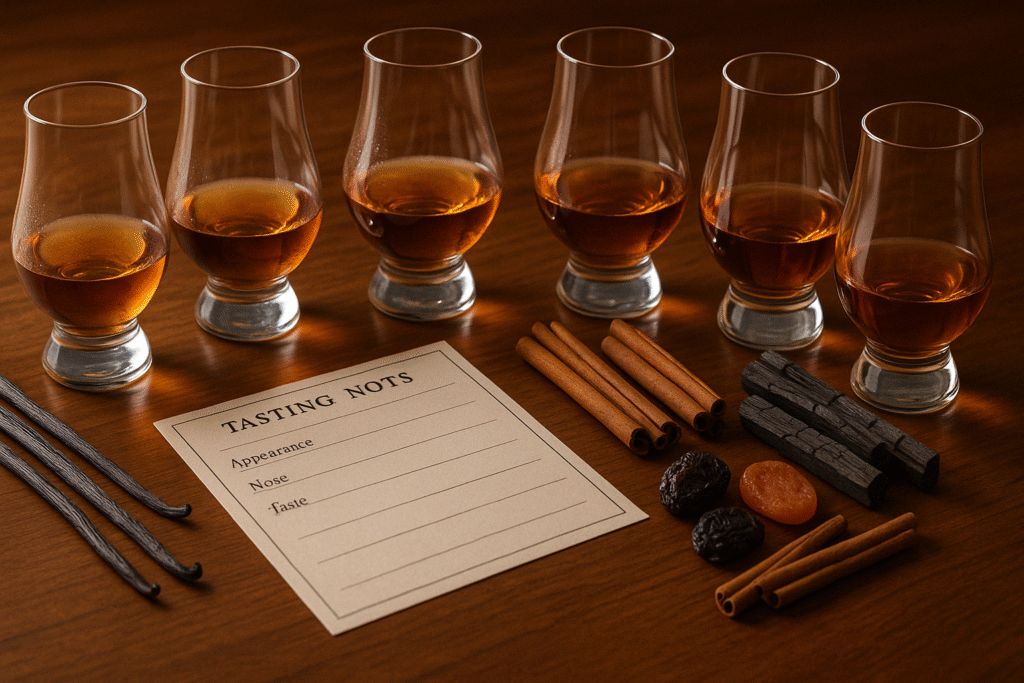
Key Flavour Components
While law dictates that no flavourings or colour additives may be added to bourbon, it nevertheless has a diverse flavour profile, typically characterised by vanilla, oak, caramel and spice.
These flavours derive from several sources:
- Grain Influence:
- Corn: Provides sweetness and body
- Rye: Adds spicy and peppery notes (learn more about whiskey and rye)
- Wheat: Contributes softness and subtle sweetness
- Malted Barley: Adds nutty and toasty notes
- Barrel Influence:
- Vanilla, caramel, and butterscotch from wood sugars
- Tannins and oak spice
- Toast and smoke from the char
- Fermentation and Distillation:
- Fruity esters
- Floral notes
- Grainy character
Common Bourbon Flavour Categories
Bourbon flavour profiles often fall into broad categories:
- Traditional/Classic: Well-balanced between sweetness, spice, and oak
- High-Rye: More prominent spice notes with a robust character
- Wheated: Softer, sweeter profile with less spice
- High-Proof/Barrel Strength: More concentrated flavours with greater intensity
Professional Tasting Approach
When tasting bourbon, consider these elements:
- Appearance:
- Colour (ranging from pale gold to deep amber)
- Viscosity/legs on the glass
- Clarity
- Nose/Aroma:
- Initial impressions
- Primary aromas (grain, fruit, floral)
- Secondary aromas (oak, spice, caramel)
- Ethanol intensity
- Palate/Taste:
- Entry (first impression)
- Development (how flavours evolve)
- Texture and body
- Balance of sweetness, acidity, spice, and oak
- Finish:
- Length (short, medium, long)
- Lingering flavours
- Heat or warmth
- Overall impression
Tasting Techniques
To get the most from a bourbon tasting:
- Glass Selection: Use a tulip-shaped glass that concentrates aromas (find the best whiskey glasses)
- Serving Temperature: Taste at room temperature (60-65°F/15-18°C)
- Rest Time: Allow the bourbon to rest in the glass for a few minutes
- Nosing Technique: Approach with mouth slightly open to reduce ethanol impact
- Tasting Method: Take a small sip, allow it to coat the mouth, then analyse the flavours
- Professional Approach: Learn how to taste whiskey like a pro
Water and Ice Considerations
- Adding a few drops of water can “open up” bourbon by releasing more aromatic compounds
- Ice will chill and dilute bourbon, which can subdue some flavours while making others more prominent
- Consider trying a bourbon neat first, then experimenting with water or ice
How to Build a Bourbon Collection
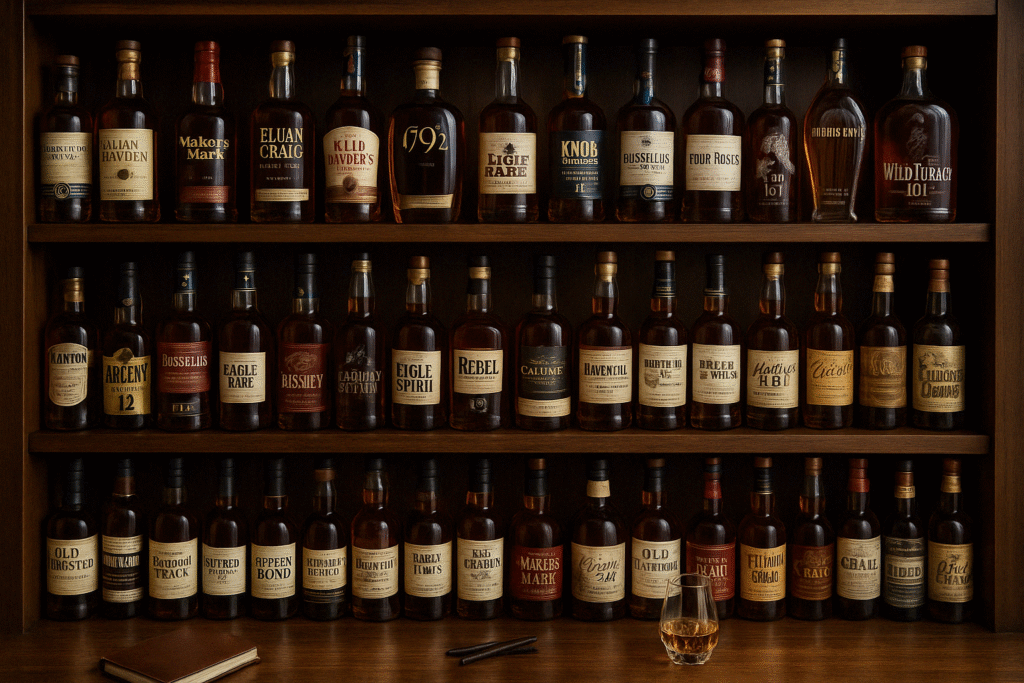
Starting Your Journey
Building a bourbon collection is an enjoyable process that can be approached methodically:
- Establish a Budget:
- Determine how much you’re willing to spend per bottle
- Consider allocating funds for different tiers (everyday, special occasion, investment)
- Create a Diverse Foundation:
- Begin with representative examples from different style categories
- Include varying proof points and age statements
- Sample both major producers and craft distilleries
- Develop Your Palate:
- Keep tasting notes to track preferences
- Attend tastings and bourbon events
- Explore related whiskey styles for perspective
Collection Categories
Consider organising your collection to include:
- Everyday Bourbons: Affordable, accessible bottles for regular enjoyment
- Special Occasion Bourbons: Higher-end releases for celebrations
- Unique Expressions: Limited editions, single barrels, or unusual finishes
- Vertical Collections: Multiple age statements or releases from the same distillery
- Historical Significance: Bottles that represent important moments in bourbon history
Storage Considerations
Proper storage is essential for maintaining your collection:
- Temperature: Store bottles at a consistent, cool temperature (55-65°F/13-18°C)
- Light Exposure: Keep bottles away from direct sunlight
- Bottle Position: Store upright to prevent cork deterioration
- Humidity Control: Maintain moderate humidity to prevent cork drying
- Security: Consider secure storage for valuable bottles
Collecting Strategies
Depending on your goals, consider these approaches:
- Drinking Collection: Focus on bottles you intend to open and enjoy
- Investment Collection: Acquire limited releases with appreciation potential
- Thematic Collection: Collect based on regions, distilleries, or styles
- Vintage Collection: Focus on specific periods or historical releases
Acquiring Rare Bourbons
For those seeking hard-to-find bottles:
- Develop Relationships: Build connections with local liquor stores
- Join Bourbon Clubs: Participate in groups that share information about releases
- Attend Bourbon Events: Many special releases are available at festivals
- Consider Secondary Markets: Research legal methods for acquiring rare bottles
- Trading Communities: Connect with other collectors for trades
Bourbon in Cocktails and Culinary Applications
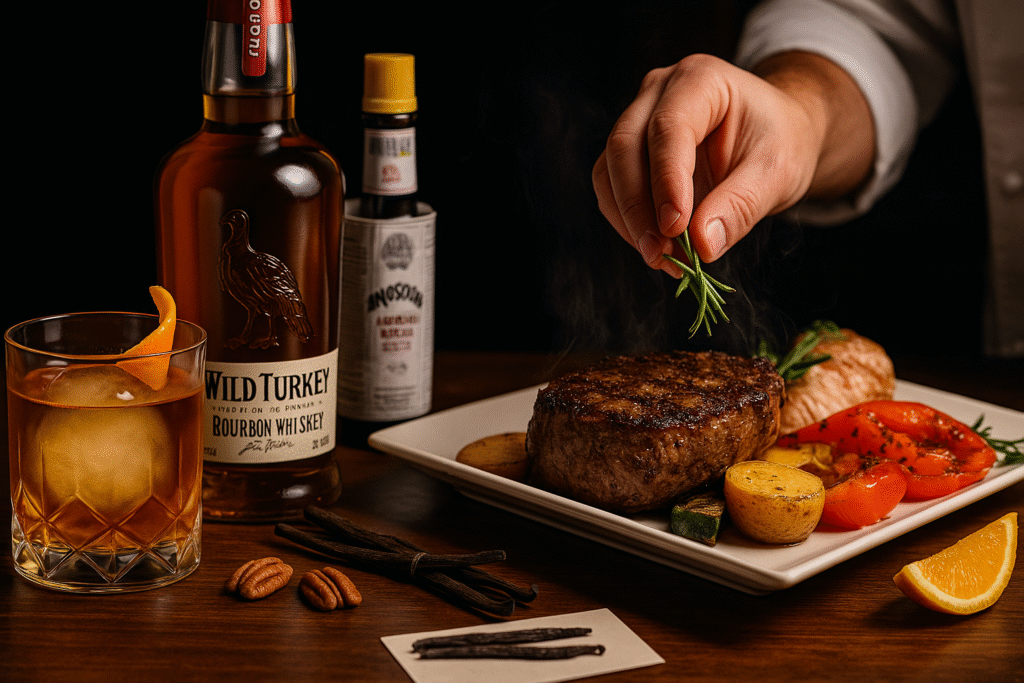
Classic Bourbon Cocktails
Bourbon is the featured spirit in many cocktail recipes, from the classic old-fashioned to the refreshing mint julep. These fantastic cocktails utilise bourbon’s unique flavour profile.
Popular bourbon cocktails include:
- Old Fashioned: Bourbon, sugar, bitters, and orange peel
- Manhattan: Bourbon, sweet vermouth, and bitters
- Mint Julep: Bourbon, mint, sugar, and crushed ice
- Whiskey Sour: Bourbon, lemon juice, and simple syrup
- Paper Plane: Bourbon, Aperol, Amaro Nonino, and lemon juice
- Boulevardier: Bourbon, Campari, and sweet vermouth
Bourbon in Cooking
Beyond cocktails, bourbon adds complexity to many culinary creations:
- Savoury Applications:
- Bourbon glazes for meats
- Deglazing sauce base
- Marinades and brines
- Explore top bourbon brands for cooking
- Sweet Applications:
- Bourbon vanilla desserts
- Pecan pie with bourbon
- Ice cream and custards
- Preservation Methods:
- Bourbon-infused fruits
- Barrel-aged maple syrup
- Bourbon vanilla extract
Conclusion
Bourbon is more than just a category of whiskey—it embodies American craftsmanship, history, and innovation. From its humble beginnings to its current global popularity, bourbon continues to evolve while maintaining its distinctive character and legal requirements.
Whether you’re sipping it neat, mixing it in a cocktail, or building a collection, bourbon offers a rich tapestry of flavours and experiences. By understanding its production, regional variations, and tasting approach, you can more fully appreciate what makes this spirit unique.
This guide serves as a starting point for your bourbon journey. As you explore further, you’ll continue to find new expressions, techniques, and applications that expand your appreciation for America’s native spirit.
